Recipes
On this page, I share easy, everyday recipes. Healthy and delicious: those two qualities go hand in hand here!
What’s your signature dish?
Which of your go-to dishes are a favourite among your friends and family? Feel free to send in your recipe, so I can add it here. Sharing is caring, because we all want to serve good and tasty food.
Let’s team up
Want to collaborate? Be sure to let me know. After all, it takes a village … to come up with new recipes and take pictures of them. Of course, I’m also just really curious to learn how you use our products!
Cosy moments together
Finally, I’d love to share in the joy of your dinners and get-togethers. Don’t hesitate to send me your pictures of those cosy aperitifs among family and friends, and I will make sure they find their way to our social channels.
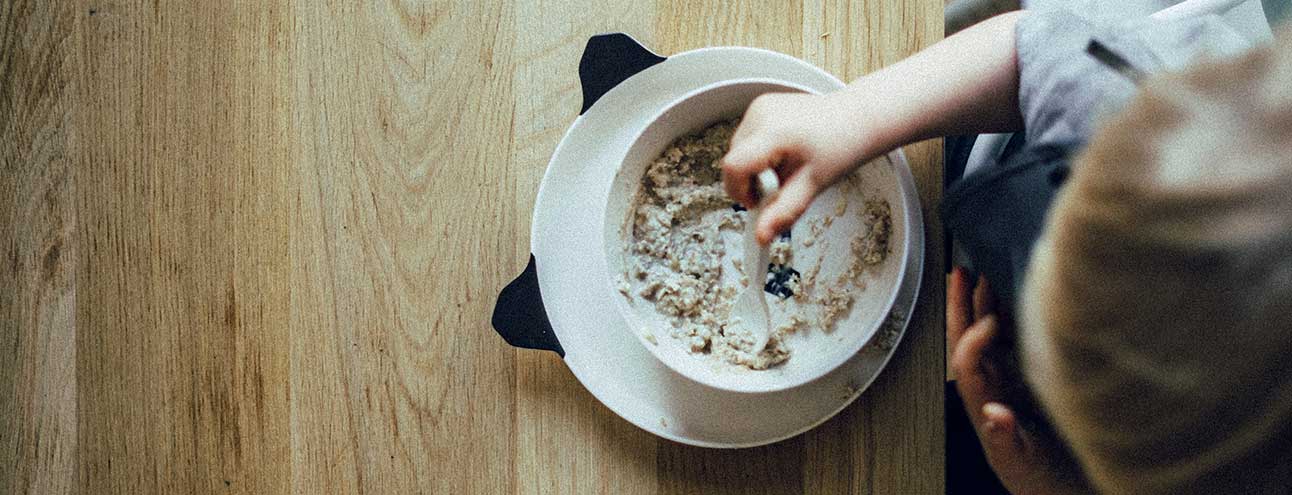
OATMEAL 4 M+
Ingredients
- 4 to 6 spoonfuls of oatmeal for babies (the label should say 4 m+)
- 180 ml of breast milk or organic baby milk
- 6 banana slices
Heat the milk in a saucepan until it reaches body temperature. Add the oatmeal and stir. Mash the banana and add it to the porridge.
Rise and shine; your lovely breakfast bowl is ready!
Feel free to experiment with other grains than oats: you can also use spelt, rice, buckwheat or semolina for babies. Make sure to opt for organic rice, though, to avoid variants that are high in arsenic.
From the age of 12 months, you can safely switch to the regular, unsweetened oatmeal you use to cook your own porridge.
Did you know that oatmeal is high in vitamin B1 and the mineral chromium, among other things?
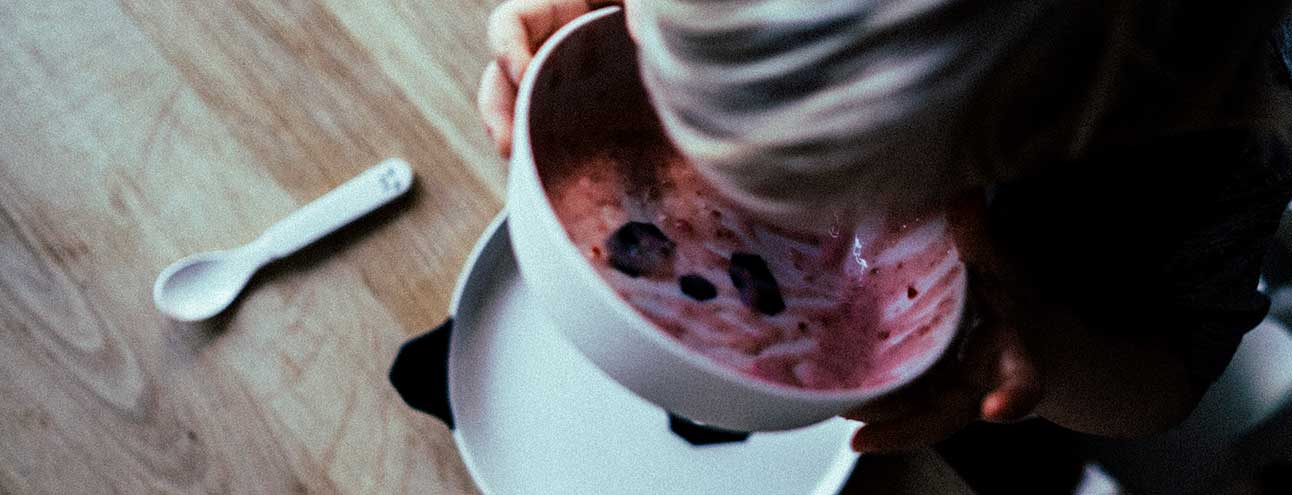
QUARK WITH FRESH SEASONAL FRUIT (AND GRAINS) 12 M+
Ingredients
- 6 spoonfuls of quark
- 2 strawberries
- 3 raspberries
- optional: 1 spoonful of spelt porridge
Wash the strawberries and the raspberries, mash them and swirl them through the quark. Add the spelt flour if you wish.
Do you want your kid to be able to drink the quark from a cup? Just mix the mixture to make it more fluid.
From the age of 12 months, you can also put yoghurt on the menu. Just replace the quark in this recipe with the same amount of yoghurt.
GREEN PUREE WITH BROCCOLI AND TOFU 6 M+

- 55 g potatoes
- 56 g carrots
- 56 g broccoli
- 30 g tofu
- 3 g grass-fed butter
Peel the carrots and the potatoes. Snap the broccoli into florets. Wash the vegetables and slice the carrots, potatoes and tofu. Steam the vegetables and the tofu for 30 minutes.
Add the grass-fed butter, mash or mix the ingredients, and serve the purée to your little one at body temperature.
If you want to give your baby something to bite on, just keep a few pieces of every vegetable aside.
The broccoli makes sure this purée is rich in the minerals iron and sulfur, in beta-carotene, different types of vitamin B, vitamin C (which promotes iron-absorption) and vitamin K. The carrots, in turn, provide the necessary vitamin A (in the shape of beta-carotene), while the grass-fed butter treats your little one to plenty of vitamin A, D and E. The tofu, lastly, brings healthy proteins to the table.
Feel free to swop the grass-fed butter for olive oil, sesame oil, flaxseed oil or rapeseed oil. Keep in mind, though, that some oils should not be heated. It’s best to add them at the end.
FRUIT (PUREE) WITH NUT PASTE 6 M+
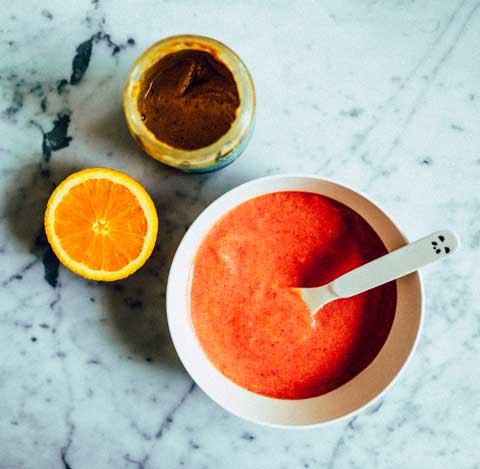
- 1 banana
- 5 raspberries
- 3 strawberries
- 1/2 orange
- 1 teaspoonful of nut paste (pick a paste that contains no sugar, salt or added oils)
Peel the banana, and give the raspberries and the strawberries a rinse. Mash or mix the ingredients. Peel and mix the orange, and add it to the mixture. Stir a teaspoonful of nut paste into the purée.
This fruity snack provides your baby with different types of vitamin B, vitamin C, minerals (like calcium, magnesium, zinc, manganese and chromium) and essential fatty acids.
Is your kid not too keen on cold fruit purée? That’s not so surprising! After all, he only had food served to him at body temperature up until now. Why not heat the purée in a little saucepan, then? Fruit not tastes better, but is also easier to digest when cooked.
TOMATO SOUP WITH TOAST 8 M+
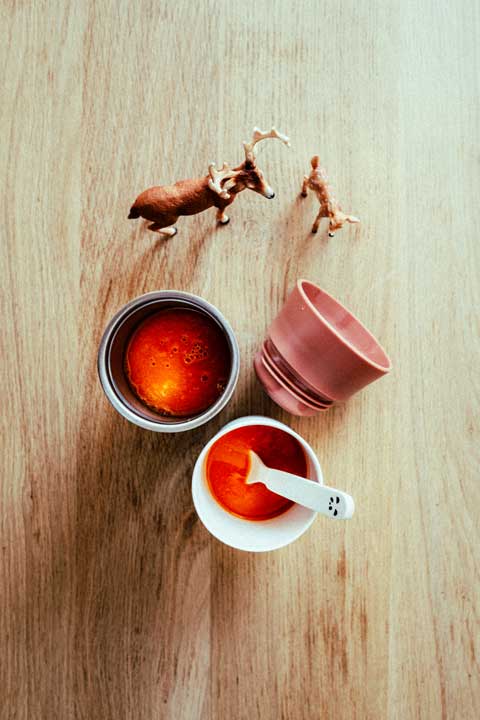
- 4 tomatoes (400 g)
- 3 carrots (250 g)
- 1/4 zucchini (100 g)
- 1 spoonful of olive oil
- a slice of organic bread
- optional: nut paste
Peel the carrots. Wash the tomatoes and the zucchini. Cut the vegetables into equally sized chunks and fry them in the olive oil. Add 500 ml of water and let the soup simmer for about 20 minutes. Add another 500 ml of water. Let the soup simmer for yet another 20 minutes, and add an extra 100 ml of water. Make sure to keep the lid on the pan. Don’t use stock cubes, because they are often way too salty for children. If you do want to add some extra flavour, fresh parsley or basil are a perfect alternative.
Purée the mixture in a vitamix or blender, or blend smooth with a hand-blender. Voila, your soup is ready! Toast a slice of bread to go with it, and spread it with nut paste if you like.
This delicious red soup is rich in vitamin E (the olive oil makes sure of that), beta-carotene (thanks, carrots), lycopene, vitamine C and iron (that’s the tomatoes’ doing). Enjoy!
MUSHROOM OMELETTE 6 M+
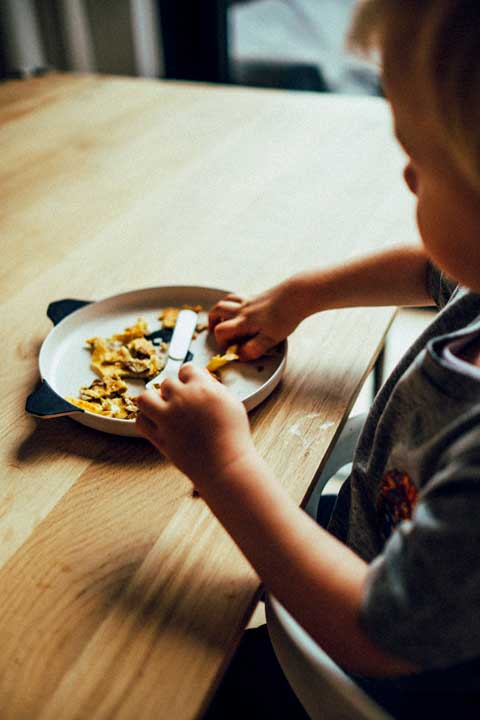
- 1 egg
- 50 g mushrooms
- 1 spoonful of olive oil
Clean the mushrooms with a brush and chop them into pieces. Beat the egg. Heat some olive oil in a pan and fry the mushrooms until golden-brown. Whisk the eggs into the pan and cook for a few moments. Let the omelette cool down and … watch your baby enjoy his food!
Pssst, this omelette is a perfect savoury snack, too.
Did you know that eggs are truly healthy and that there really is no limit to how many eggs people should eat in a week? An egg is obviously a complete protein, but it also contains vitamin A, different types of vitamin B (like B12), vitamin D, calcium, iron, zinc, sulfur and selenium – each and every one of them an essential vitamin or mineral. What’s more, eggs are rich in lecithins (phospholipids), which help the brain develop.
